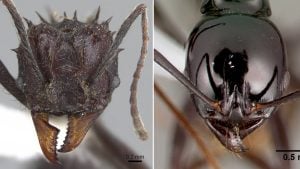

While many of us were baking sourdough during lockdown, a team of researchers embarked on a fascinating lockdown project: capturing close-up photos of ants. They ended up with nearly 12,000 images, revealing a mesmerizing world of grooves, ridges, and dimples on ants’ little heads and bodies. They don’t only look fascinating – but they may potentially be the key to ant survival.
Entomologist Clint Penick of Auburn University in Alabama started the project during the COVID-19 pandemic. He was at Kennesaw State University in Georgia at the time and worked alongside his students to gather the data. The 11,739 photos they took show a variety of faces of these fascinating little creatures. Most ants have a nice and smooth outer surface. However, some grow elaborate patterns, “like dimples on a golf ball” or “cracks in mud,” says Penick.
Ancyridris polyrhachioides © April Nobile/antweb.org
Chrysapace jacobsoni © Erin Prado/antweb.org
The researchers went a step further, mapping these textures onto an evolutionary tree of ants. Their analysis revealed a fascinating story. All those dimples and textures have evolved from smooth-faced ancestors. Some textures disappeared, only to reappear millions of years later. This evolutionary dance hinted at a hidden advantage, suggesting these patterns weren’t just random decorations. In fact, they may be crucial to survival for ants living in different conditions.
However, for now, this is just a theory. Evolutionary morphologist Brendon Boudinot noted that similar textures might not serve the same purpose in different species. Fingerprint-like ridges, for example, appear in both sand-digging ants and trap-jaw ants. But while the former need abrasion resistance, the latter don’t. For them, the face patterns might play a different role. They might serve to “diffuse stress or strain when those jaws are cocked,” Boudinot assumes, speaking to Science News.
Penick agrees that further research is needed to confirm the exact benefits of these intricate patterns. He envisions textures boosting structural support, influencing microbial growth, or even playing a role in ant communication.
What we see in them surely are amazing “portraits” with plenty of diversity. They even inspired textile designer Meredith West Owens to create abstract fabric patterns. But I won’t lie, they’re also kinda scary. Certainly, these photos are a neat way to connect science, nature, and art (and a dash of horror). So, now I leave you to more of them, and you can see plenty more on antweb, a dedicated website of this project.
Acromyrmex © Michele Esposito/antweb.org
Acanthomyrmex thailandensis © W. Jaitrong/antweb.org
Acanthomyrmex © April Nobile/antweb.org
Tatuidris © April Nobile/antweb.org
Myrmecia mjobergi © Z. Lieberman/antweb.org
Myrmecia © Michele Esposito/antweb.org
Myrmecia borealis © Z. Lieberman/antweb.org
Myrmecia © April Nobile/antweb.org
Myrmecia analis © Z. Lieberman/antweb.org
Megalomyrmex adamsae © John T. Longino/antweb.org
Lioponera suscitata © Noel Tawatao/antweb.org
Lioponera © Michele Esposito/antweb.org
Apomyrma © Erin Prado/antweb.org
Lioponera aberrans © Estella Ortega/antweb.org
Lioponera aberrans © Estella Ortega/antweb.org
Cephalotes atratus © April Nobile/antweb.org
Aneuretus simoni © April Nobile/antweb.org
Ankylomyrma coronacantha © Ryan Perry/antweb.org
Agroecomyrmex duisburgi © Vincent Perrichot/antweb.org
Acromyrmex ameliae © Gabriela de Figueiredo/antweb.org
[via PetaPixel]







